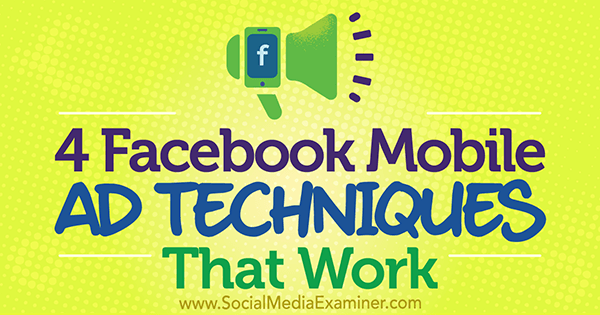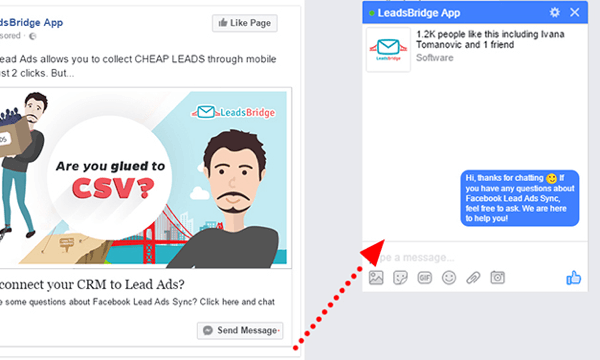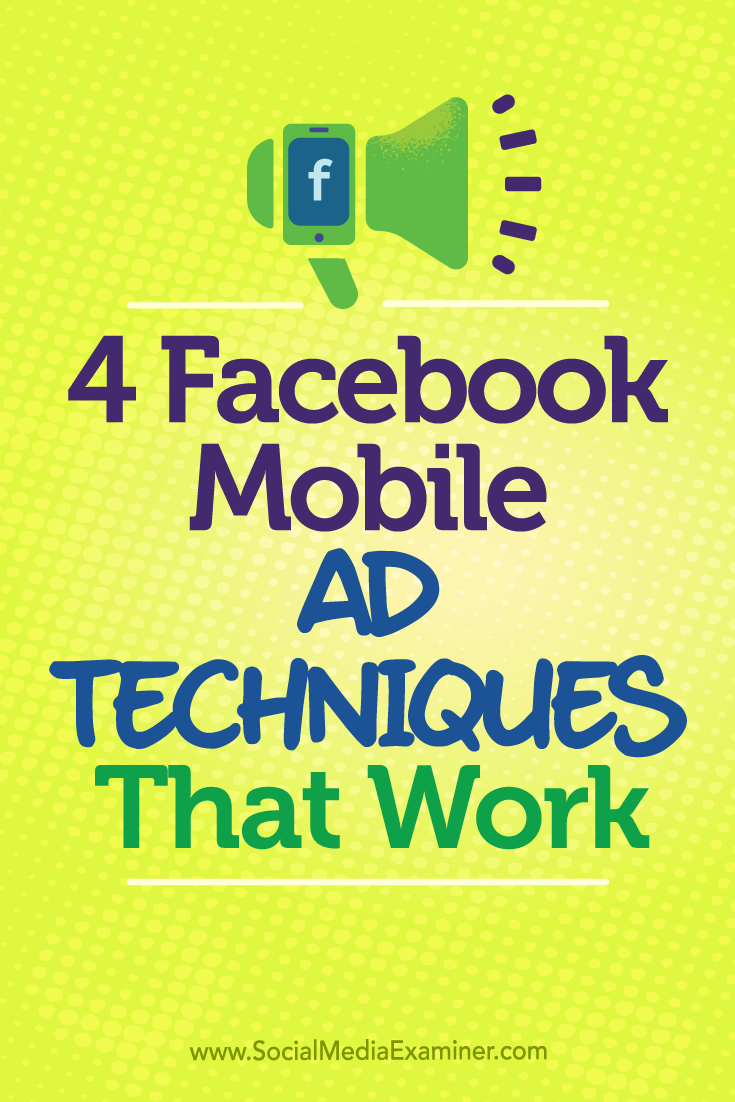 Are you looking for ways to reach people on their mobile devices?
Are you looking for ways to reach people on their mobile devices?
Are your Facebook mobile ads working?
Facebook has tools to help you create compelling ads that enhance your mobile marketing efforts.
In this article, you'll discover four ways to improve results from your mobile Facebook ad campaigns.

#1: Start a Conversation With Messenger Destination Ads
Facebook has developed ads that drive people from their news feed to a chat through Messenger.
These Messenger destination ads include a call-to-action (CTA) button that links directly to Messenger. The principle is simple: Once people click your ad, they're redirected to a chatbot that appears with a welcome message through which you can give further instructions.
If you sell goods or services that require a long purchasing process, you may find this new ad product useful. In fact, in such cases, people may need to get in touch with you several times before deciding to buy anything.
For example, if you offer financial services or run a nurturing campaign, chatting with potential customers may be significant in setting up an appointment or closing a sale.

With every Messenger destination ad campaign, you can target people through interests, behaviors, and more. It may be even more effective to combine these ads with a retargeting strategy. You can create custom audiences for people who have visited a specific page on your website, such as your sales pages, without buying anything.
#2: Simplify Signups With Facebook Lead Ads
Facebook's lead ads are particularly effective in generating leads, as they allow people to subscribe in just two clicks.
A traditional Facebook ad campaign redirects users to a landing page on your website, where they can complete a subscription form. In this case, your website's loading time is crucial, because potential customers could leave before opting in. According to Dynatrace and Akamai surveys, 50% of website visitors expect sites to load within 2 seconds, and if they don't load within 3 seconds, people will abandon the process.
Facebook lead ads are specifically designed for mobile traffic and you don't need a landing page to generate leads. Instead, when people click your ad, Facebook will automatically populate the opt-in form with their data, making the signup process simple and fast.

The downside to Facebook lead ads is that any contacts you collect during your advertising campaign are placed in a CSV file inside your Facebook page's publishing tools. This means that each time you log in, you'll need to upload this data to your CRM or ESP system. It's a time-consuming task that can decrease the quality of your leads proportionally with any increased time it takes to contact them back.
Get World-Class Marketing Training — All Year Long!
Are you facing doubt, uncertainty, or overwhelm? The Social Media Marketing Society can help.
Each month, you’ll receive training from trusted marketing experts, covering everything from AI to organic social marketing. When you join, you’ll also get immediate access to:
- A library of 100+ marketing trainings
- A community of like-minded marketers
- Monthly online community meetups
- Relevant news and trends updates

Discover Proven Marketing Strategies and Tips
Want to go even deeper with your marketing? Check out the Social Media Marketing Podcast! Publishing weekly since 2012, the Social Media Marketing Podcast helps you navigate the constantly changing marketing jungle, with expert interviews from marketing pros.
But don’t let the name fool you. This show is about a lot more than just social media marketing. With over 600 episodes and millions of downloads each year, this show has been a trusted source for marketers for well over a decade.
If you take advantage of Lead Ads, remember it's a new format which requires you to pay close attention to the entire funnel.
#3: Create an Immersive Experience With Canvas Ads
Facebook created canvas ads to help marketers increase engagement on mobile devices. However, when Facebook first rolled them out, many people thought the ads met the needs of only big businesses and enterprises. The reality is that canvas ads can be profitable for small businesses and solopreneurs too.
Facebook canvas ads provide an in-depth, fast-loading experience for mobile users. You can combine videos, still images, and CTA buttons and create attractive landing pages inside Facebook that load in a fraction of a second. These ads offer a mobile user experience that a website can't provide.
Here's an example of a Facebook canvas ad from TOMS. Note how quickly the landing page opens.
.
Thanks to canvas ads, you can propose more effective landing pages to increase brand awareness, generate leads, and boost sales.
#4: Target Only Mobile Website Visitors With Ads
It doesn't matter if your website is 100% responsive; when people visit it through their mobile devices, they always miss something, including crucial information or CTAs.
To increase your ROI on campaigns, run specific campaigns for people who surf your site through mobile. There's a technique you can use to convert these users into leads and customers, while reducing your marketing budget and timing:
When creating a new audience on Facebook, click Custom Combination to define a custom audience from website traffic. Then add your URL and select only mobile users.

From here, create a new campaign and ad set, and select your new custom audience as the target for your ads. Thanks to this retargeting tactic, you can set up more effective campaigns that target mobile users who already know you but haven't completed your desired action.
Conclusion
We're at the beginning of a new advertising age. Facebook's total expected revenue for 2016 will be around $25 billion, and nearly 80% of Facebook's revenue already comes from mobile advertising. According to Internet Live Stats, in the time it took you to read this article, 100 smartphones were purchased worldwide in comparison to only 10 personal computers.
If you're running traditional Facebook ad campaigns that drive users to landing pages, it could be a reason why your marketing efforts are getting harder. Fortunately, Facebook is creating new products that can help you optimize marketing campaigns on mobile devices.
As Facebook says, mobile is not a technology; it's a behavior. Rather than simply investing in mobile, you need to create a mobile funnel that fits this behavior.
With the tools mentioned above, you can run marketing campaigns that increase leads and sales without even using your website, which is the biggest problem for mobile advertisers right now.
As a smart marketer, don't forget to use split tests, enjoy the new advertising age, and keep an eye on new products Facebook is developing for mobile advertising.
What do you think? Do you use some of these tactics for mobile ads? What tips can you share? Feel free to leave a comment and ask questions concerning these techniques. I'll be glad to help you apply them to your advertising strategy!

Attention Agency Owners, Brand Marketers, and Consultants

Introducing the Marketing Agency Show–our newest podcast designed to explore the struggles of agency marketers.
Join show host and agency owner, Brooke Sellas, as she interviews agency marketers and digs deep into their biggest challenges. Explore topics like navigating rough economic times, leveraging AI, service diversification, client acquisition, and much more.
Just pull up your favorite podcast app, search for Marketing Agency Show and start listening. Or click the button below for more information.

